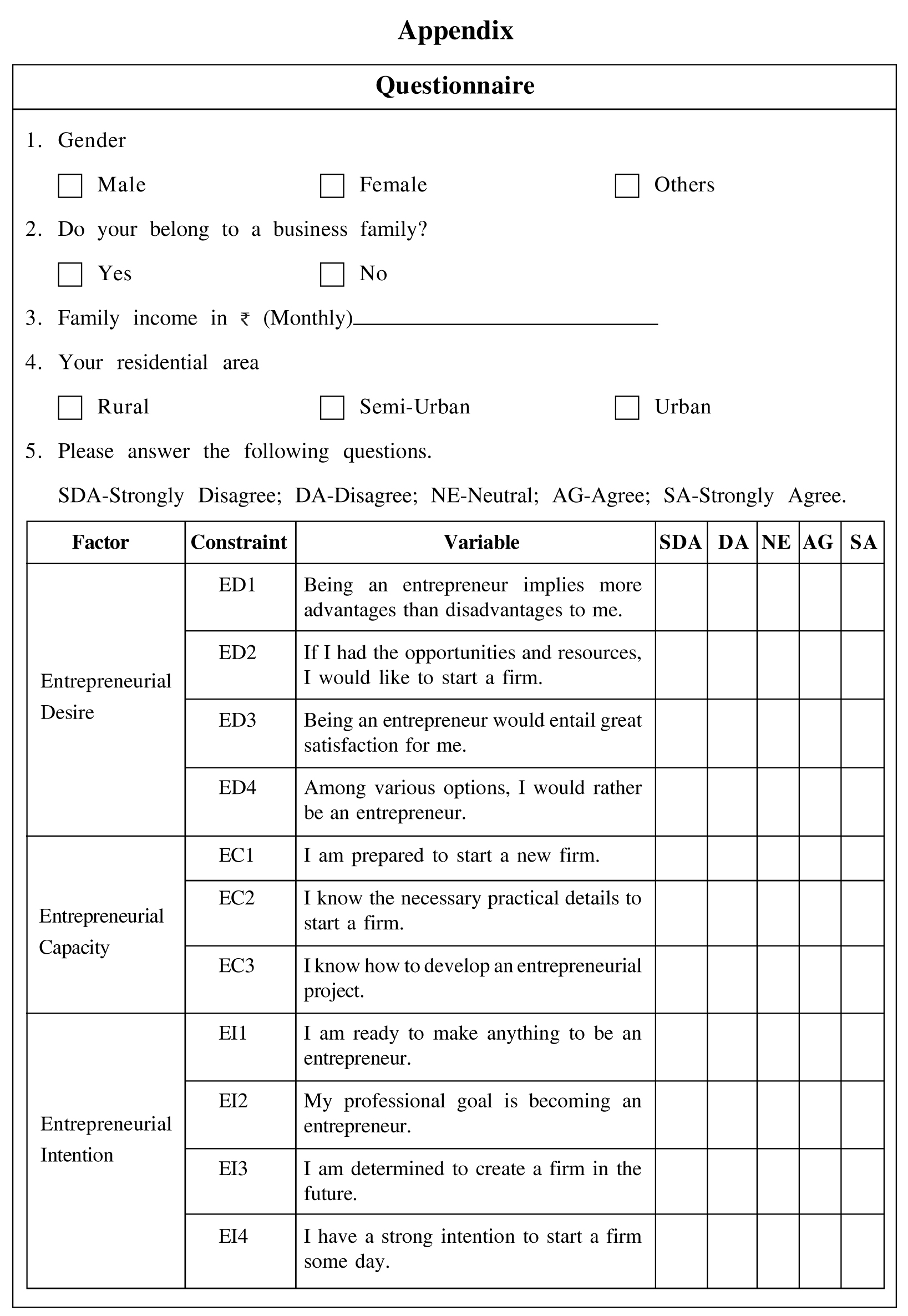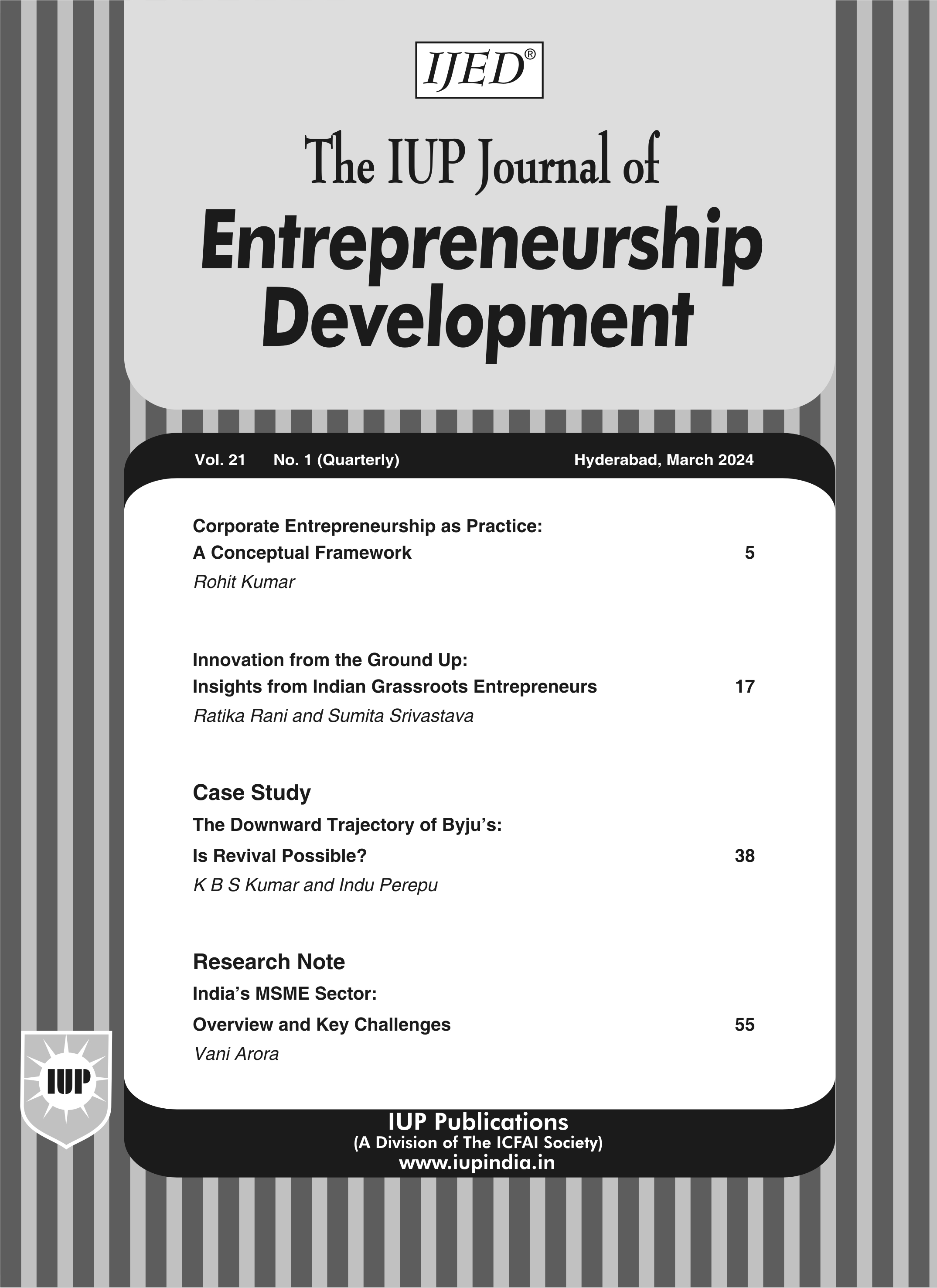
June'20
The IUP Journal of Entrepreneurship Development
Archives
A Study on College Students' Perception of Entrepreneurial Traits in the Midst of Covid-19
V Jayanthi
Assistant Professor, Department of Business Administration, VISTAS, Chennai, Tamil Nadu, India.
E-mail: jayanthiii.murali@gmail.com
The young entrepreneurs share the task of the government in providing employment prospects to the deprived. The government cannot provide occupation to all the needy. The entrepreneurs are the moral fiber of the economy. The college students are the future entrepreneurs who are going to raise the economic growth. Hence, it is imperative to study the perceptions of the students in this regard at this gloomy juncture of Covid-19. The study was done during the lockdown period through online survey.
Introduction
India is at the crossroads and we have to continue our journey towards "Athmanirbhar Bharat",
besides getting funds through FDI. The manufacturing sector in India has to be fueled with
FDI funds to boost domestic production in collaboration with multinational companies. The
multinational companies are turning towards India to shift their bases. This will not only fetch
employment openings but also get opportunities for other allied services such as spares
supply, housekeeping, transport, hotel and hospitality industry, etc.
The entrepreneurs are the backbone of any economy. Especially, given the recent
economic condition, it is the MSME sector which is going to play a vital role in lifting the
economy. The government has also provided assistance to the MSME sector in the current
financial haul up announcements. The new applicants will enjoy the benefits and help in the
easy launch of their business. The students in the present situation are anxious as there are
less job openings in the country due to the economic setback owing to the global pandemic
which has diverted them to the start-ups and other forms of businesses. An increase in
university licensing, patenting and start-up creation in the US has also been observed in many
countries in Europe and Asia, as well as in Australia, Canada, and Israel (Grimaldi et al., 2011).
It is the paramount obligation of the government to provide all the necessary facilities and
motivate them. The government has to abridge the measures to persuade the students to turn
their ideas into reality. A cell has to be introduced predominantly for students to process their
proposal.
The main purpose of the study is to bring out the perceptions of student community in
the present context and evaluate the entrepreneurial intention of students from various strata.
Literature Review
Krueger and Brazeal (1994) came out with a Theory of the Entrepreneurial Intention as a
planned activity. The authors state that intentions are the single best predictor of planned
behaviors. Their sample consisted of 126 university students, both male and female. This
study begins by testing Shapero's (1975) model by examining the direct effect of feasibility
and desirability perceptions and propensity to act on entrepreneurial intentions. The sources
of exposure to entrepreneurship are one's family business, a business started by another
relative or friend, working in someone else's small business, and starting one's own business.
They found that situations and individual differences are the exogenous factors that affect
entrepreneurship. Social norms play a wider role than family and friends in supporting the
entrepreneurs. They state that understanding entrepreneurial intention helps in comprehending
idea generation and turning them into successful venture. The authors suggest that mere
teaching the skill is not enough but training should be given for actual use of the skill learnt.
Dhanalakshmi (2020) studied the entrepreneurial intention of the commerce students
whose syllabus is mainly oriented towards business. The author analyzed the factors such as
opportunity, motivation, fear of failure and the entrepreneurial intention among university
students. The findings of the study are: education enhances the entrepreneurial spirit in students
by providing knowledge and skill to cope with the real-time challenges. The technical
knowledge and motivation from teachers are the main factors that induce entrepreneurial
intention. Entrepreneurial education and hands-on-training boost the spirit of starting a business.
The lucrative salary offers in the campus interview diverts the business intention of the students.
The final year students are to be encouraged to come out with business ideas.
Siegel and Wright (2015) explored the commonalities among old and new entrepreneurial
theories. In this study, the ability to cope with the risk, the tolerance level, perceived
feasibility and perceived net desirability were studied to predict the intention for
entrepreneurship. This study was conducted at Florida Gulf Coast University examining 114
undergraduate business studies students. The results of the study proved that tolerance for risk,
perceived feasibility and net desirability predicted the self-employment intention.
Shetty (2011) evaluated the challenges and threats to small and medium-scale enterprises.
The author states that small and medium-scale enterprises play a vital role in the economic
development of the country. The SMEs make up 90% of the enterprises in most countries
worldwide. The SMEs are the genesis of new innovations which are the driving force for the
growth of the country. The SMEs play a crucial role in poverty alleviation and distribution
of wealth. The SMEs are dependent mostly on creativity, discovery and innovation. The rapid
change in technology leads to new idea generation and new knowledge which keeps the
SMEs active and successful in their venture.
Denoble (2004) studied the early developmental views on self-employment and
personality (openness, neuroticism, etc). He collected data from 342 students from groups in classes at educational institution and analyzed their perceptions on perceived ability and
personal investment using regression analysis. Personality, gender and having a close relative
as an employee are factors that motivate a person to start a business. Neuroticism is negatively
related to intent and ability.
Locke and Baum (2004) explored the role of entrepreneurial traits, motivation
(communicated vision, self-efficacy, goal, etc.) and skill (passion, tenacity, etc.) in consequent
venture growth. The authors state that the previous studies on entrepreneurship and leadership
theories have helped in the hypothesis framing for the study. The authors collected data from
both the chief executives as well as associates in a six-year longitudinal study. Structural
equation model was used to bring out the relationship. Goal, communicated vision and selfefficacy
have direct effect on venture growth and these factors also mediated passion, tenacity
and new resource to growth.
Objective
- To map the demographic profile such as gender, family background, income and residential area of the students.
- To study their perception about entrepreneurship.
- The data is collected through a well-structured questionnaire (see Appendix). The questionnaire has both personal data and questions related to the entrepreneurial perception.
- The items are presented on a Likert scale ranging from 1 (Strongly Disagree) to 5 (Strongly Agree).
- The entrepreneurial desire has four constraints, entrepreneurial capacity has three constraints and entrepreneurial intention has four constraints.
- The Cronbach's alpha is 0.9 which proves internal consistency.
- Data is collected through online survey via WhatsApp and e-mail.
- Total 139 responses were received.
- Percentage analysis, Chi-Square and ANOVA are used for analysis of data.
Data and Methodology
This study is mainly based on Krueger and Breazel's (1994) Entrepreneurial Potential Model. Susanj (2015) examined the entrepreneurial potential of both business orientation group and non-business orientation group and hit upon the concept that entrepreneurship was a planned activity and it was more predictable among students with business guidance. SreckoGoic (2002) observed the students of nine countries and discovered that some cultures are conducive to entrepreneurship. Linan (2006) studied individuals of Spain and Taiwan for their entrepreneurial potential and held that personal attraction and perceived social norms play a vital role in upholding the entrepreneurship traits. Ajjan (2015) studied the perception of individuals in Egypt and the US for their self-efficacy and access to social media to promote entrepreneurial intention. It was observed that self-efficacy on social media is more significant in Egypt than in the US. Dissanayake (2013) studied the undergraduate students in Sri Lanka and concluded that entrepreneurial intention is determined by behavioral beliefs, self-efficacy and credibility. Binks (2005) stated that there is a need for broadening of human and social capital for encouraging entrepreneurship innovation. Ajjan (2015) found that entrepreneurial competence and entrepreneurial interest are mainly supported by the personality traits and parenting. Murphy et al. (2006) state that the impact and importance of entrepreneurial fields is increasing in academic and practical settings. Nam et al. (2009) believe that the proprietor can get the required human capital only through formal education and experience in marketing management. Shettar (2011) stated that technological advancement has a say in the growth of SSIs. The survival of business depends on the adoption of the changing environment. Based on these observations, the following hypotheses are framed (Table 1).
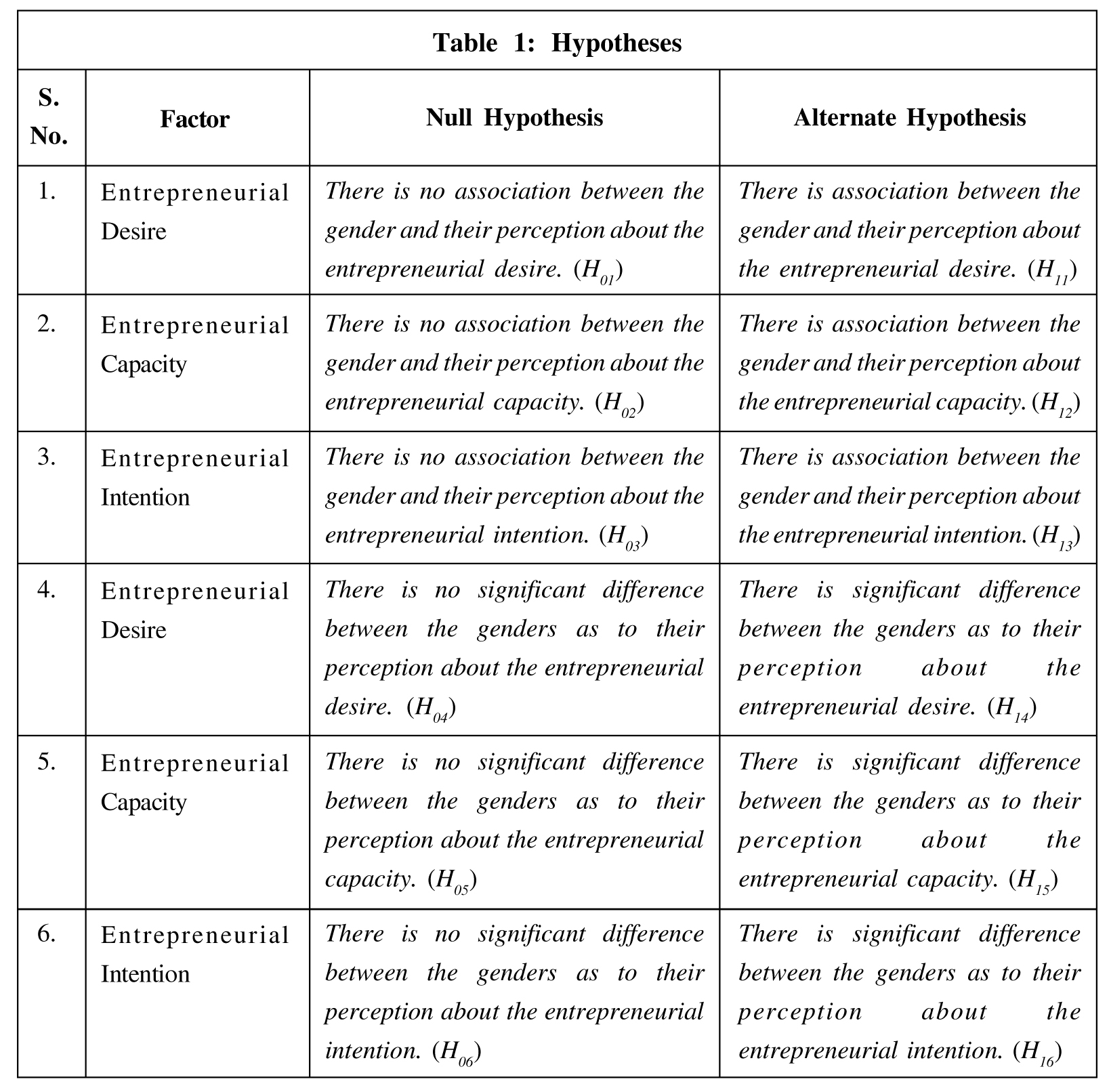
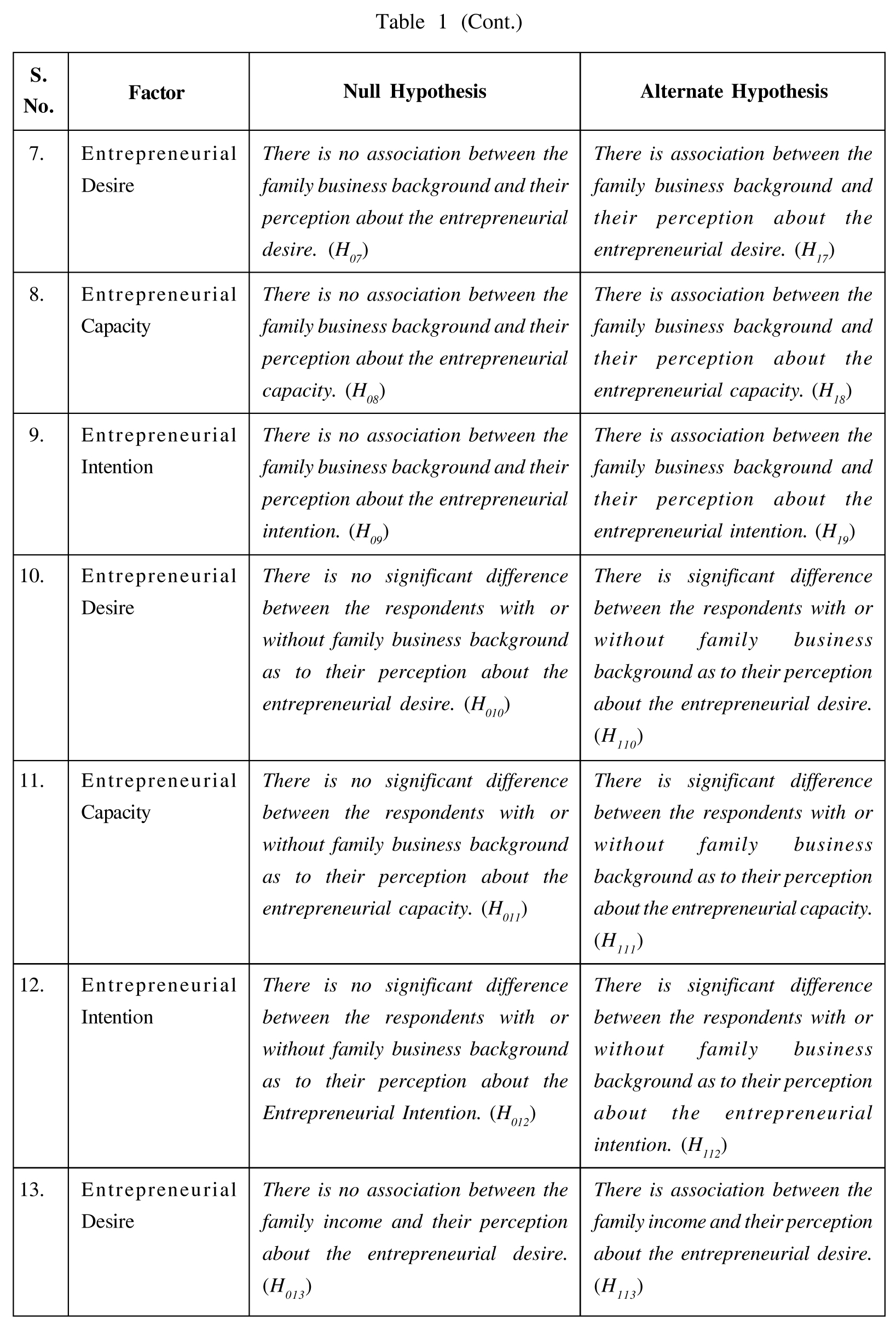
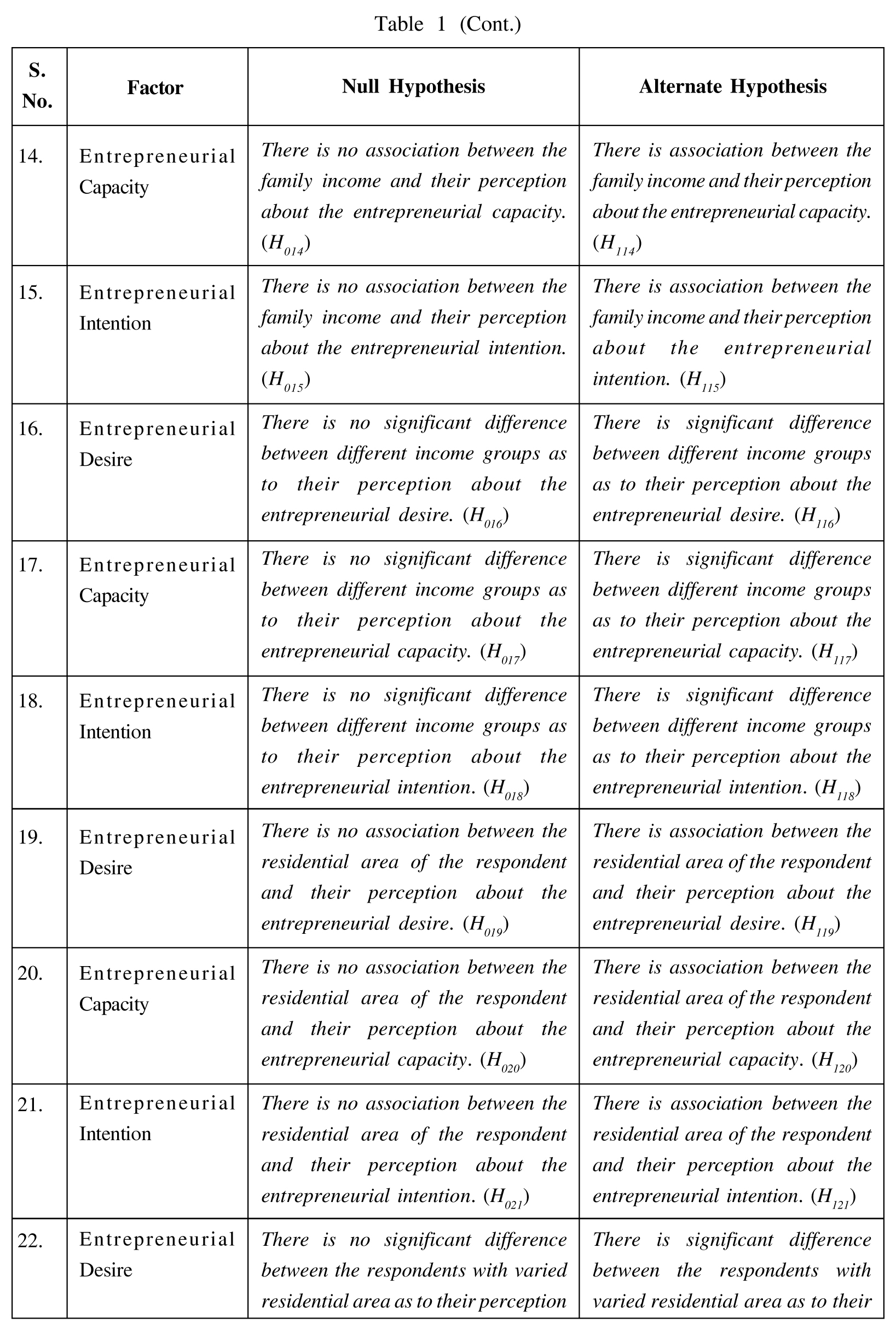
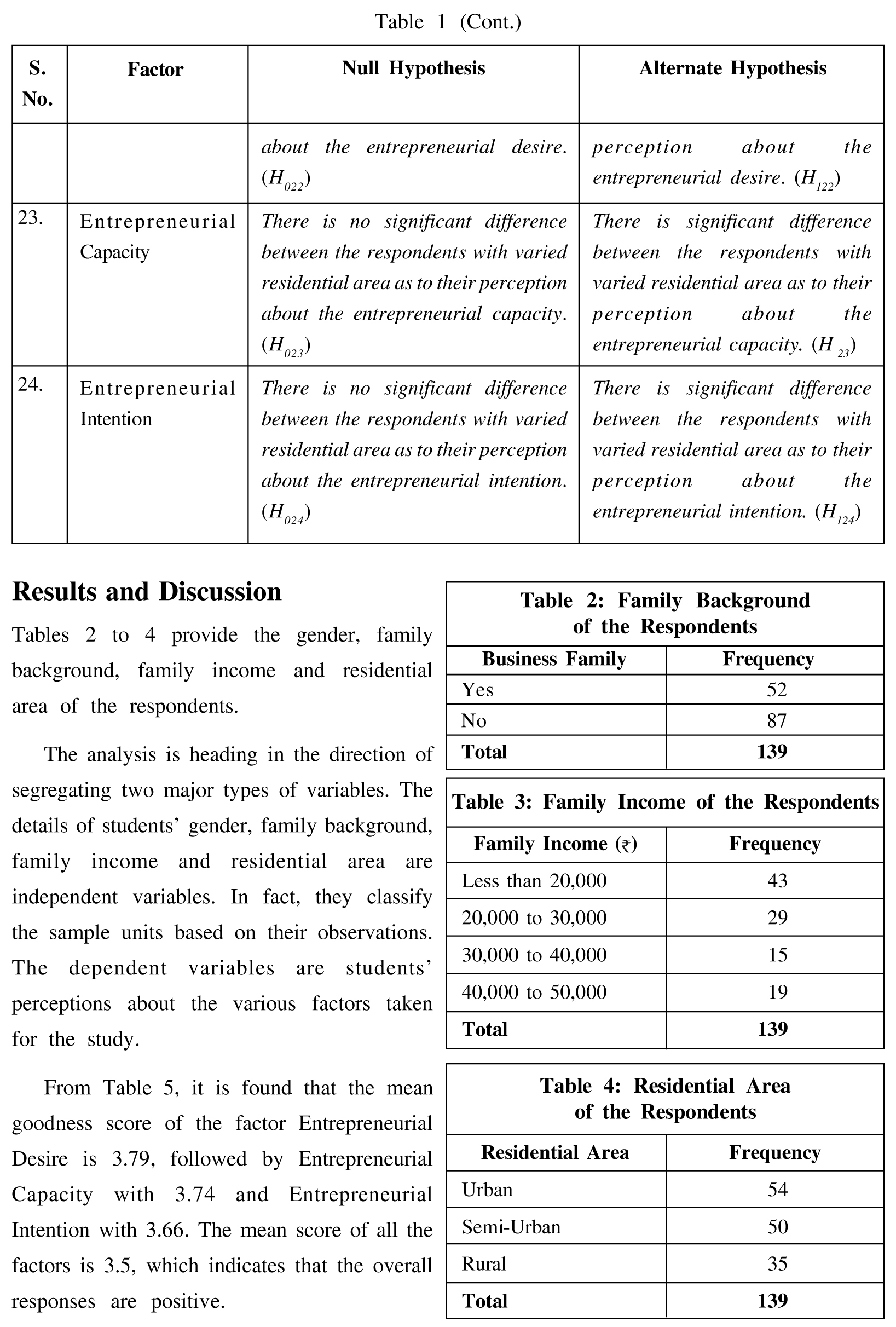
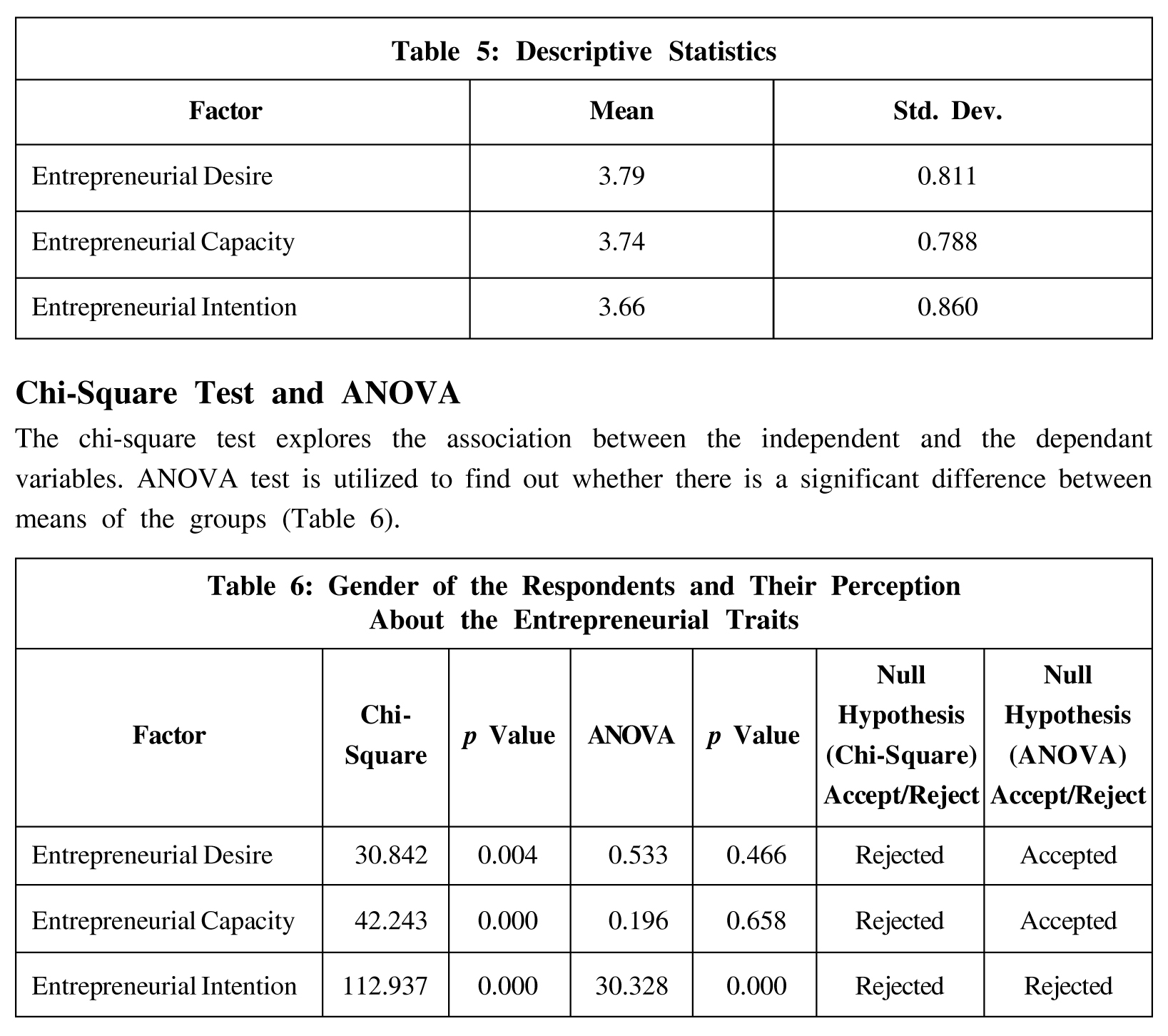
H01,H02 and H03:
There is no association between the genders and their perception about the
entrepreneurial traits.
H04, H05 and H06:
There is no significant difference between the genders as to their perception about
the entrepreneurial traits.
As far as the chi-square test is concerned, the p value for Entrepreneurial Desire is 0.004,
Entrepreneurial Capacity is 0.000 and Entrepreneurial Intention is 0.000. All are less than
0.05, so we can declare that there is an association between gender and their perception.
As with ANOVA test, the p value for Entrepreneurial Desire is 0.466 and Entrepreneurial
Capacity is 0.658, which points out that there exists significant difference between the
genders as to their perception of Entrepreneurial Desire and Entrepreneurial Capacity. The p
value of Entrepreneurial Intention is 0.000 which indicates that there is no significant
difference between the genders in their perception.
H07, H08 and H09:
There is no association between the respondents with or without family business
background and their perception about the entrepreneurial traits.
H010, H011 and H012:
There is no significant difference between the respondents with or without family
business background and their perception about the entrepreneurial traits.
As far as the chi-square test is concerned, the p value for Entrepreneurial Capacity is 0.004
and Entrepreneurial Intention is 0.000. The p value is less than 0.05, so we can conclude that
there is an association between the family business background and the perception. In the case
of Entrepreneurial Desire with p value of 0.167, there is no association between the family
business background and their perception (Table 7).
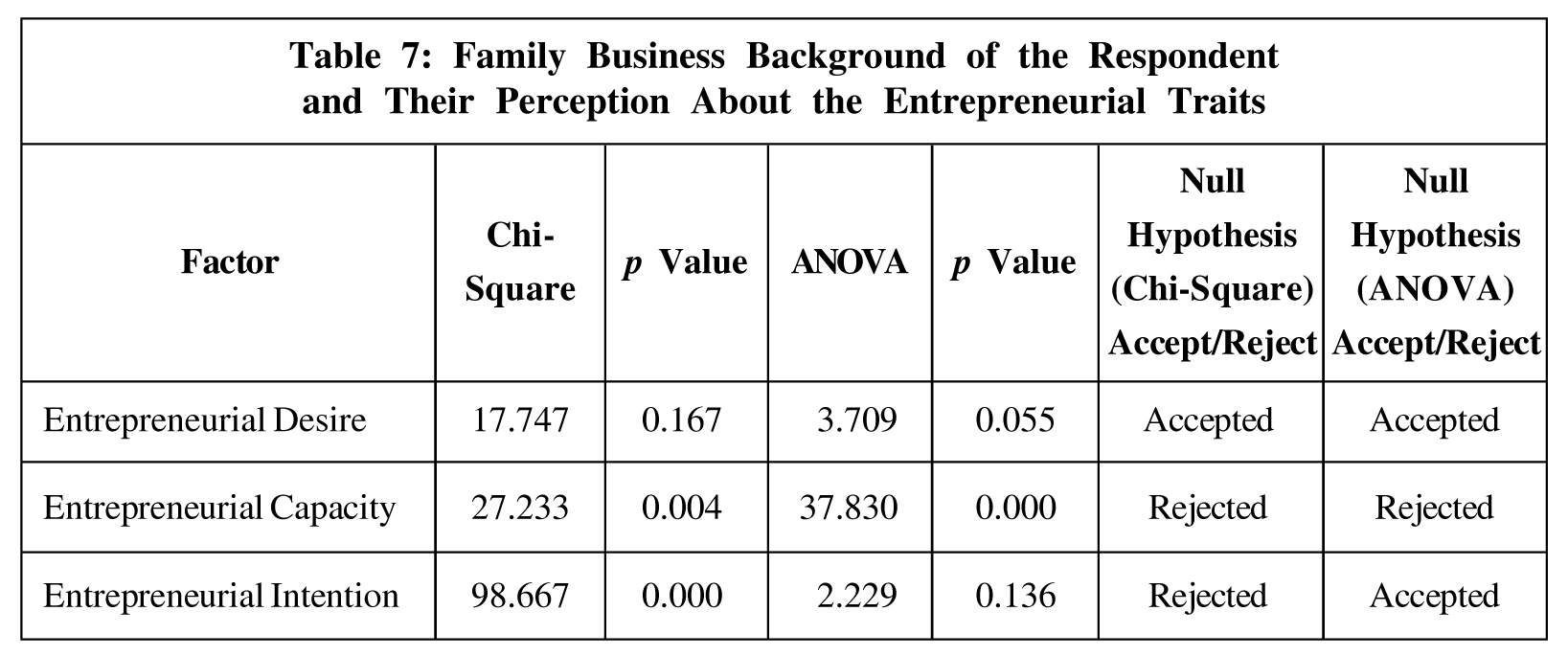
As with the ANOVA test, the p value for Entrepreneurial Desire is 0.055 and
Entrepreneurial Intention is 0.136 which points out that there exists significant difference
between the students with and without family business background as to their perception of
Entrepreneurial Desire and Entrepreneurial Intention. The p value of Entrepreneurial Capacity
is 0.000 which indicates that there is no significant difference between the students with and
without family business background in their perception.
H013, H014 and H015:
There is no association between family income and their perception about the
entrepreneurial traits.
H016, H017 and H018:
There is no significant difference between different income groups and their
perception about the entrepreneurial traits.
As far as the chi-square test is concerned, the p value for Entrepreneurial Desire is 0.000,
Entrepreneurial Capacity is 0.004 and Entrepreneurial Intention is 0.000. The p value is less
than 0.05, so we can declare that there is an association between the family income and the
perception (Table 8).
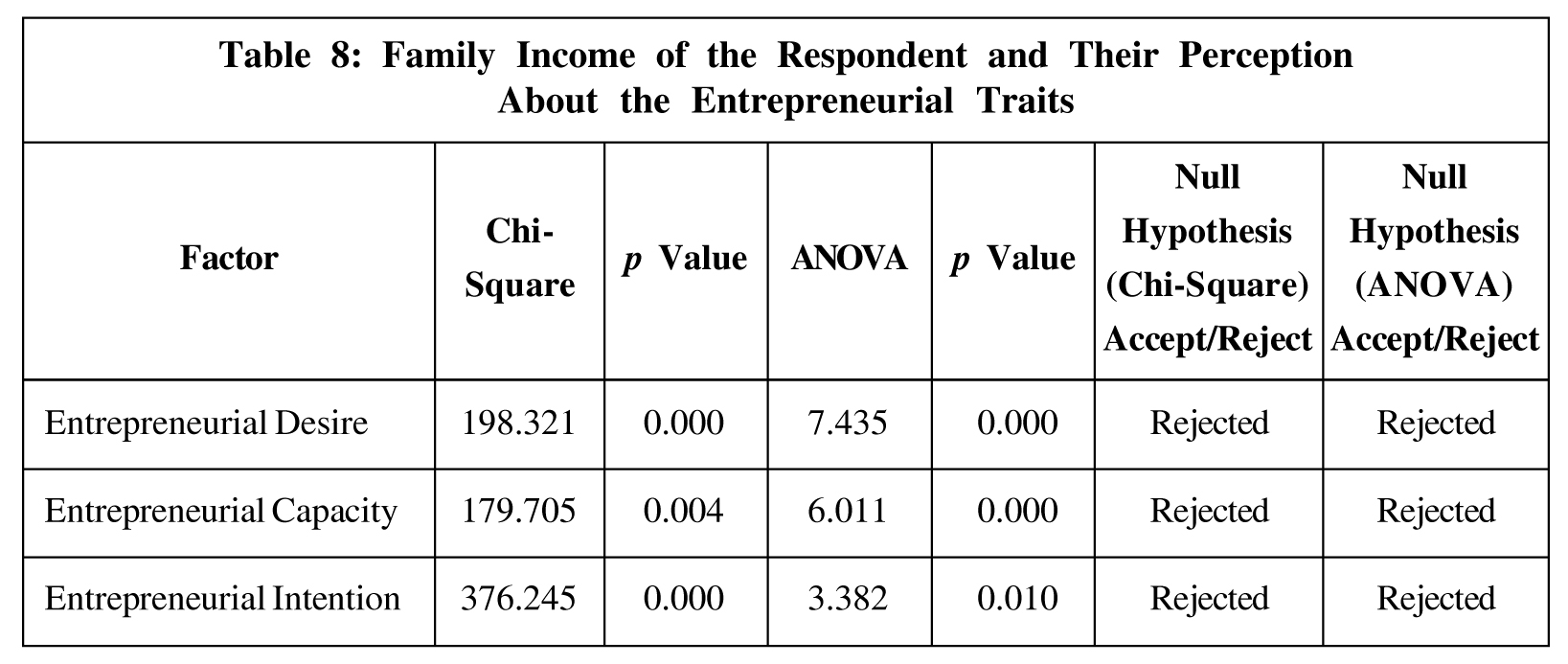
As with ANOVA test, the p value for Entrepreneurial Desire is 0.000, Entrepreneurial
Capacity is 0.000 and Entrepreneurial Intention is 0.010. There exists no significant difference
between the students with varied family income as to their perception of Entrepreneurial
Desire, Entrepreneurial Capacity and Entrepreneurial Intention.
H019, H020 and H021:
There is no association between the respondents with varied residential area of the
respondent and their perception about the entrepreneurial traits.
H022, H023 and H024:
There is no significant difference between the respondents with varied residential
area and their perception about the entrepreneurial traits.
As far as the chi-square test is concerned, the p value for Entrepreneurial Desire is 0.000,
Entrepreneurial Capacity is 0.000 and Entrepreneurial Intention is 0.000. The p value is less
than 0.05, so we can conclude that there is an association between the residential area of the
respondent and their perception (Table 9).
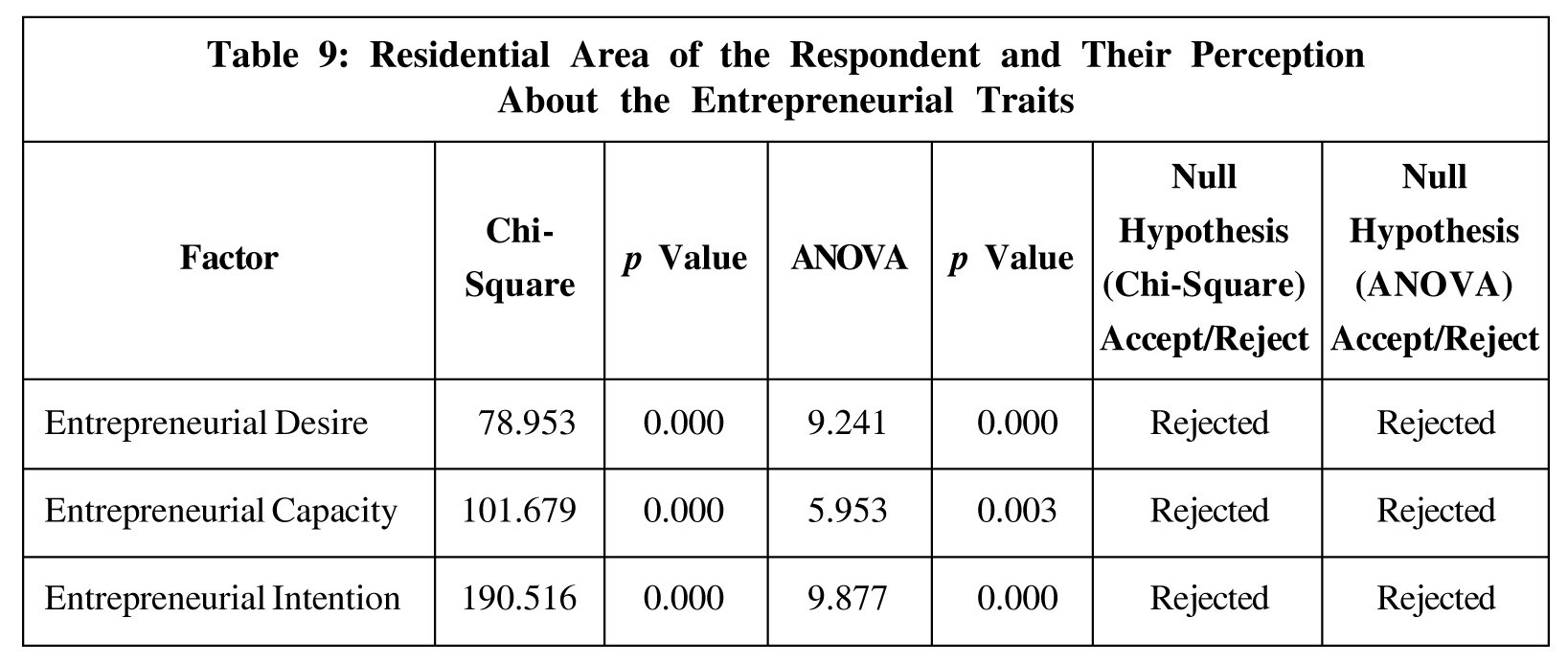
As with ANOVA test, the p value for Entrepreneurial Desire is 0.000, Entrepreneurial Capacity is 0.003 and Entrepreneurial Intention is 0.000. There exists no significant difference between the students from varied residential areas as to their perception of Entrepreneurial Desire, Entrepreneurial Capacity and Entrepreneurial Intention.
- It is found that there is some difference between the genders as to their perception and there is significant difference between the genders as far as the Entrepreneurial Intention is concerned. This may be attributed to the cultural impact.
- The family business background has no association with the perception of Entrepreneurial Desire. Irrespective of family business background, the students have identical zeal for entrepreneurship.
- The family income has nothing to do with the desire and intention of the entrepreneurs.
- The residential area has no role in the entrepreneurial perception of the students (Table 10). The area and the neighbors have little role in the discernment. It is the mindset of the individual which plays a vital role.
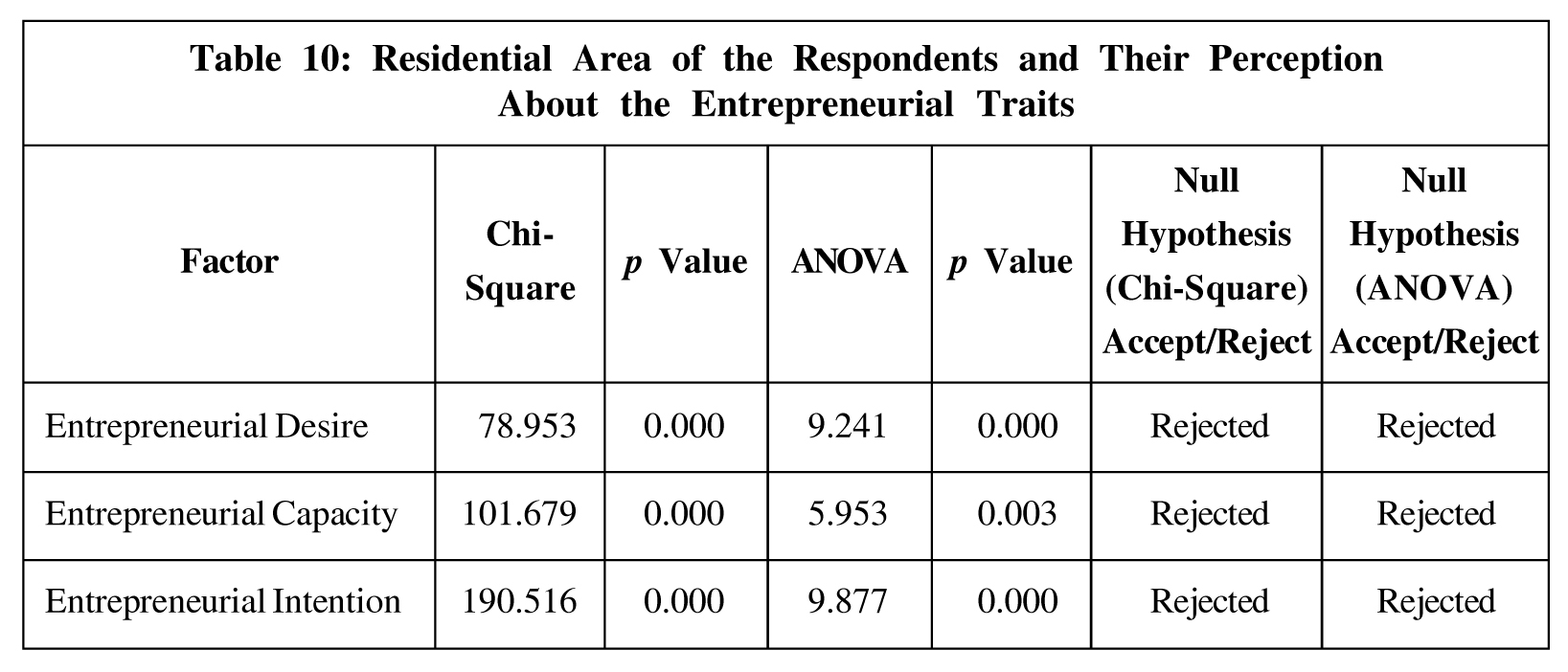
Recommendations
- The students are to be encouraged at the college level to come out with innovative ideas.
- The licensing and registration procedures are to be simplified.
- The Mudra loan procedures have to be simplified to promote it among the college students.
Conclusion
We are in a grim economic situation and it is the responsibility of the government to take
all the necessary steps to encourage the entrepreneurs who can create job opportunities. From
this study, we have come to know that the students, irrespective of their family background
and residential area, have entrepreneurial desire which is to be encouraged. The students are
to be imparted skills at the college level. It is high time that we focused on academic entrepreneurship. We need to discuss a series of issues related to academic entrepreneurship to
encourage students to come out with strategy formulation, implementation at the university,
policy formulation and assessment at government level. The universities and the colleges have
to maintain an excellent affiliation with MSME department. The issues relating to nature of
incubation centers and the patent rights are to be cleared and pave way to mobility, international
entrepreneurship, and fair dealing. The author is of the view that more people will be attracted
towards entrepreneurship if corruption and the procedural delays are curbed. It is certain that
India will become 'Athmanirbhar' and be at top of the globe in the coming decade.
References
- Ajjan Haya F A (2015), "Social Media Use to Support Entrepreneurship", Journal of Developmental Entrepreneurship, Vol. 20, No. 3, pp. 1-28.
- Binks Martin P D (2005), "Novice, Serial and Portfolio Entrepreneur Behaviour and Contributions", Small Business Economics, Vol. 25, No. 2, pp. 109-113.
- Denoble G S (2004), "Views on Self-Employment and Personality: An Exploratory Study", Journal of Developmental Entrepreneurship, Vol. 8, No. 3, pp. 265-288.
- Dhanalakshmi K R and Muthulakshmi K (2020), "Assessment of Entrepreneurial Intention Among College Students with Special Reference to Commerce Students of Arts & Science Colleges in Chennai City", Parishodh, Vol. 9, No. 2, February, pp. 263-272.
- Dissanayake D (2013), "The Impact of Perceived Desirability and Perceived Feasibility on Entrepreneurial Intention Among Undergraduate Students in Sri Lanka: An Extended Model", The Kelaniya Journal of Management, Vol. 2, No. 1, pp. 39-57.
- Grimaldi R, Kenny M, Seiegel D S and Wright M (2011), "30 Years After Bayh-Dole Reassessing Academic Entrepreneurship", Research Policy, Vol. 10, No. 10, pp. 1045-1057.
- Krueger N F Jr and Brazeal D V (1994), "Entrepreneurial Potential and Potential Entrepreneurs", Entrepreneurship Theory and Practice, Vol. 18, No. 1, pp. 91-104.
- Linan F A (2006), "Testing the Entrepreneurial Intention Model on a Two-Country Sample", Document de Treball Universitat Autonoma de Barcelona: Departament d'Economia de l'Empresa, Working Paper No. 0607, pp. 1-37.
- Locke Edwin A and Baum Robert J (2004), "The Relationship Entrepreneurial Traits, Skills and Motivation to Subsequent Venture Growth", Journal of Applied Psychology, Vol. 89, No. 4, pp. 587-594.
- Murphy Patrik J, Liao Jianwen and Welsch Harold P (2006), "A Conceptual History of Entrepreneurial Thought", Journal of Management History, Vol. 12, No. 1, pp. 12-35.
- Nam Hoang, Sonobe T and Otsuka K (2009), "An Inquiry in to the Transformation Process of Village-Based Industrial Clusters: The Case of Iron and Steel Cluster in Norther Vietnam", Journal Comparative Economics, Vol. 27, No. 4, pp. 568-581.
- Schmitt-Rodermund E (2004), "Pathways to Successful Entrepreneurship: Parenting, Personality, Early Entrepreneurial Competencies and Interests", Journal of Vocational Behavior, Vol. 65, No. 3, pp. 498-518.
- Shapero (1975), "The Displaced, Uncomfortable Entrepreneur", Psychology Today, Vol. 9, No. 11, pp. 83-88.
- Shettar N R (2011), "Perspectives on the Problems of Sickness of SSI Sector", Southern Economist, Vol. 30, No. 4, pp. 42-45.
- Shetty K A (2011), "Innovation and Indian SMEs: Emerging Challenges Opportunities", Southern Economist, Vol. 11, No. 11, pp. 11-14.
- Siegel D S and Wright D A (2015), "Academic Entrepreneurship: Time for a Rethink?", British Journal of Management, Vol. 26, No. 4, pp. 1-14.
- SreckoGoic S L (2002), "Entrepreneurial Potential in Transition Economy; A View from Tomorrow's Leaders", Journal of Developmental Entrepreneurship, Vol. 7, No. 4, pp. 399-414.
- Susanj Zoran A Z (2015), "Verifying the Model Predicting the Entrepreneurial Intention Among the Students of Business and Non-Business Orientation", Management, Vol. 20, No. 2, pp. 49-69.
